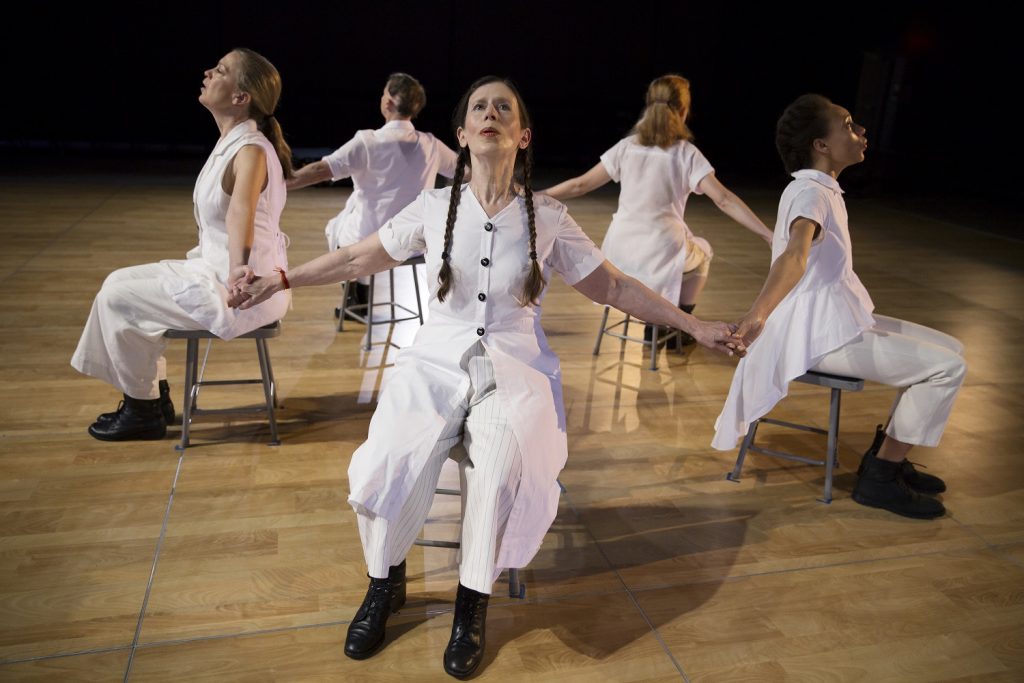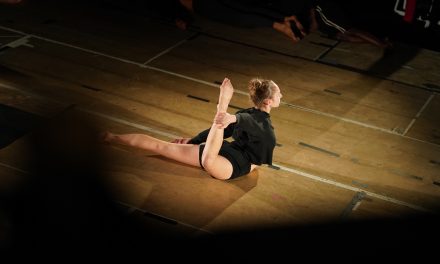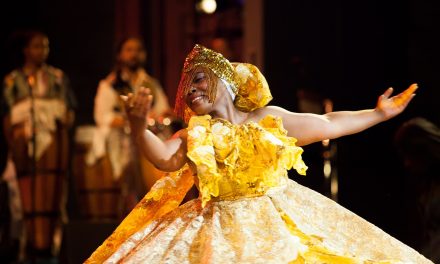What happens when minimalism meets a musical vocalist genius? Meredith Monk is the result of one such union and her Cellular Songs that appeared at CAP UCLA’s Royce Hall on Wednesday, March 2, 2019 was one of her finest to date. Founded in 1978, Meredith Monk & Vocal Ensemble is comprised of “some of the finest and most adventurous singer/ instrumentalist/ performers active in new music,” and with Cellular Songs Monk burrowed deep into the essence of life and death to bring us her version of nature’s symphony. Although Monk incorporated film projections, musical instruments and live camera feed, she remained true to her original artistic values by paring everything down to its most essential elements. There was nothing extra placed on top of the work in order to entertain. What the audience experienced at Royce Hall was the crux of what fine art can represent. Cellular Songs was, for me, the hearing, seeing and feeling of our humanity’s DNA.
The list of Monk’s talents is long. She is a composer, singer, director/choreographer and creator of new opera, music/theater works, films and installations. Known best for her vocal talents and creations, Monk has a strong dance background that in Cellular Songs she has pared down to simple, almost pedestrian, arm and hand movements that speak volumes to every human being. We recognize the gestures and know their meanings, yet Monk has taken those gestures and transformed them into a movement vocabulary that communicates both abstractly and universally.
Her work began in 1968 when Monk founded her company The House that was dedicated to combining the disciplines of music, dance and theater into her unique form of performance. It was groundbreaking at the time, but over the years her work has been recognized around the world and cross-pollinated with other art forms and genres. She was a pioneer in what has become known as site-specific performance and created works for both theater and film. Monk’s work has been presented in most of the major venues in the US and around the world, and she is the recipient of the prestigious MacArthur “Genius” Award, two Guggenheim Fellowships, three “Obies” [Off-Broadway Theater Awards] (including an award for Sustained Achievement), and two “Bessie” awards (New York Dance and Performance Awards) for Sustained Creative Achievement. She was named an Officer of the Order of Arts and Letters by the Republic of France and the 2012 Composer of the Year by Musical America. In September 2015, President Obama presented Monk with the National Medal of Arts. These are but a few of the awards and honors bestowed upon this American treasure over the span of her 50 plus year career.
Like her work, the stage was devoid of decoration. No side leg or back curtains. The theater’s rear brick wall, its large roll-up loading dock door, the light trees plus the backstage rigging were completely exposed. Not a new idea, but in Cellular Songs felt necessary rather than contrived. A film of five pairs of hands appeared on the wall and commenced in a quiet hand dance. First the thumbs moved, then the fingers and eventually the hands moved and wove together like a slow-motion kaleidoscope. The first signs of humor appeared as the hands spoke silently to each other like crocodile mouths in a shadow game.
Voices were heard as the film faded away and the lights came up revealing a piano and five low stools. We were treated first to Meredith Monk, Katie Geissinger and Allison Sniffin slowly moving up and down stage as they vocalized. They sat and gently turned their heads to glance at something in the distance, their voices harmonizing musically in wordless syllables. They stood and moved around, stopped to take short lunging positions for a subtle hand movement to become the necessary focus; all the while their vocals increasing in complexity.
They were joined by Ellen Fisher and Jo Stewart who moved in a conversational and playful duet all the while vocalizing the discussion. The choreography appeared to be tightly structured improvisational, one playing off or against the other. The difference in the two women’s height became part of the movement play and the song quietly dissolved as the lights faded to black.
From the beginning, the entire cast was dressed in white, oversized jumpsuits. As the lights came up, revealing four women seated on low metal stools, Monk performed the only song that had actual lyrics. “I am a happy woman” was sung as she performed torso and arm movements to reflect her sense of joy. The song progressed to reveal a multitude of human traits, emotions and/or feelings. Happy woman became a tender woman, thinking woman, sassy, patient, thieving, grieving, shaky, lucky, angry woman plus many more. It was a solo that showcased just some of Monk’s musical and movement talents.
One of the highlights of the evening was a solo performed by Katie Geissinger that at first sounded like utterances from a grieving woman. It was a musical lament that slowly evolved into her acceptance of the loss she suffered. Geissinger’s vocals were accompanied with taut torso movements and arm gestures of reaching, searching or questioning motifs. It felt like the audience stopped breathing during Geissinger’s performance, which spoke volumes.
What began as a soft, lyrical hand and arm solo for Jo Stewart that at times reminded me of a woman rubbing the inside of a large, porcelain bowl, changed without warning when Stewart’s character uttered a horrifying screech, clasps her chest and died. We watched and heard as the others kneel over Stewart, lay on hands and watch Stewart’s spirit stand and stare at her own body before walking into the light.
Joe Levasseur’s lighting design continuously provided visual treats as when Monk begins playing on the piano before being joined by the other four in a five-hand display of rhythms. Levasseur enriched this section by turning the back wall an emerald green, contrasting the harsh white light cast by the piano’s lamp and spot light.
The jumpsuits are removed to reveal white dresses of varying designs; all without adornment and the vocals shifted to a variety of clicks, hand claps and body rhythms. The five women paced in angular patterns while making loud exhaling sounds and hisses. They stopped, quietly twisted from side to side while their sounds became joyous, then angry with the stomping of feet added into the rhythmic mix. They sat on the stools in a circle and the musical notes traveled clockwise and counterclockwise between them. One could almost see and feel the sound swirling around them.
Large, chalky white hands appeared from above and below. At first they looked like large porcelain props but in fact were real hands projected on the wall and floor. The textures projected behind them shifted from fauna in full bloom to leafless tree branches, yet another symbol of life’s every evolving cycle from birth to death.
Off-white or cream-colored dresses in the shapes of aprons, are donned by all but Ellen Fisher who performed a solo on one of the small stools. She sat, reached and jabbed with sharp arm gestures with hands shaped like spear heads. Fisher balanced on her back, lying parallel to the floor and ceremoniously crossed her ankles as if in repose. She shifted directions, turned to lie prone on the stool; returning to her back, ankles crossed. It was a plain but dynamic show of control.
The final section of Cellular Songs began with the appearance of several young women from the National Children’s Chorus, also dressed in all white. Reddish brown splotches on the back wall turned out to be the tops of the cast’s heads projected onto the wall by a live camera feed from above. The children, who rehearsed for two weeks with the Meredith Monk & Vocal Ensemble, joined in the magic of Monk’s vocal designs. They slowly moved around, stood still, or posed in a lunge prior to the entire cast lying down. Everyone eventually ended up in three groups on the floor, each group forming a circle which could be seen clearly via the camera feed projected onto the back wall. They became the cycle of birth to death intertwined; the never-ending cycle of life.
The plain, almost staid looking costumes that fit Cellular Songs so perfectly were designed by Yoshio Yabara who was also credited with Scenography. Sound Design was by Jim Bertini; Video Scenarios/Direction by Meredith Monk; Video Design by Katherine Freer; Video Design Realization by Jorge Morales Picó; and Cinematography was by Ben Stechschulte.
The very talented young women from the National Children’s Chorus were Madison Braybon, Gabriela Danielyants, Sophia Li, Randall Lindsey, Simone Marijić Buljubasic, Hanna Rydman Santos, Mia Ruhman, Pnina Tofler, Lavinia Watkins, and Maelee Woodworth. The Artistic Director of the National Children’s Chorus is Luke McEndarfer with Associate Artistic Director, Dr. Pamela Blackstone.
For more information on Meredith Monk & Vocal Ensemble, click here.
To see the performances scheduled at CAP UCLA, click here.
For information on the National Children’s Chorus, click here.
Featured image:
Meredith Monk & Vocal Ensemble in CELLULAR SONGS – Jo Stewart, Ellen Fisher, Allison Sniffin, Meredith Monk, Katie Geissinger – Photo by Stephani Berger











